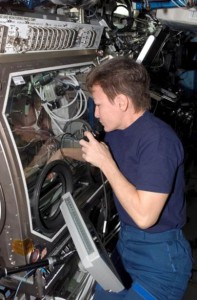In today’s A Lab Aloft entry, International Space Station Program Scientist Julie Robinson, Ph.D., continues the countdown of her top ten research results from the space station, recently presented at the International Astronautical Conference in Beijing, China. Be sure to check back for daily postings of the entire listing.
Number seven on my countdown, colloid self-assembly using magnetic fields for development of nanomaterials, is a dramatic shift in research discipline from our previous item. I picked this area of physical science study because many people don’t realize how space research can be used to advance the field of nanotechnology. This set of studies looks at colloid arrangements at a nanoscale using electrical fields. The finding was significant enough to net an award this summer at the 2013 International Space Station Research and Development Conference. Eric Furst, Ph.D., University of Delaware, received this recognition for outstanding results on Colloid Self Assembly as a top space station application.

Colloids are tiny particles suspended in a solution, which are critical in household products such as lotions, medications and detergents, as well as in industrial processes. But in this case, we are talking about a unique type of colloid studied in the Investigating the Structure of Paramagnetic Aggregates from Colloidal Emulsions (InSPACE) collection of experiments. Specifically, these are what we call Magnetorheological (MR) fluids—fluids that change their viscosity in an electric field, and can even be induced to change their arrangement at the nanoscale.
These suspensions of paramagnetic particles, meaning they are attracted to magnetic forces, can quickly solidify when exposed to a magnetic field. They return to their original state when the influence ends. This solidification process produces useful viscoelastic properties that can be harnessed for a variety of mechanical devices, from intricate robotic motions to strong braking and clutch mechanisms.
Microgravity study aboard the space station slows down the movement of these colloidal mixtures, allowing researchers to understand how they interact, and then use this knowledge to control the tiny particles on the ground. You can’t do these experiments on Earth because the nanoparticles would settle out too quickly due to gravity.

When the InSPACE study began, it identified a pulsing phenomenon that had never been seen before. This was a serendipitous result that astronaut Peggy Whitson previously discussed in this blog entry. Work continued with (InSPACE-2 and -3) investigations to further look at how magnetic fields impact colloidal self-assembly phase transitions. By better understanding how these fluids “bundle” themselves into solid-like states in response to magnetic pulses, researchers have insight into phase separation. This may lead them to new nanomaterials from these tiny building blocks for use on Earth.
This is really an exciting and continued area of endeavor on the space station, with the most recent results on nanomaterials structures of colloids published in the prestigious Proceedings of the National Academies of Science, USA. It is so simple—you have to do these studies in space because on Earth the particles settle out too quickly. However, the results are far from simple, with the most recent studies having moved far beyond the original investigation.
Julie A. Robinson, Ph.D.
International Space Station Program Scientist
